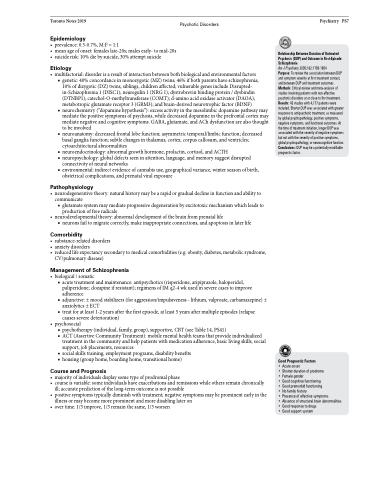Page 1171 - TNFlipTest
P. 1171
Toronto Notes 2019
Psychotic Disorders
Psychiatry PS7
Epidemiology
• prevalence:0.3-0.7%,M:F=1:1
• meanageofonset:femaleslate-20s;malesearly-tomid-20s • suiciderisk:10%diebysuicide,30%attemptsuicide
Etiology
• multifactorial:disorderisaresultofinteractionbetweenbothbiologicalandenvironmentalfactors ■ genetic: 40% concordance in monozygotic (MZ) twins; 46% if both parents have schizophrenia;
10% of dizygotic (DZ) twins, siblings, children affected; vulnerable genes include Disrupted- in-Schizophrenia 1 (DISC1); neuregulin 1 (NRG 1); dystrobrevin binding protein / dysbindin (DTNBP1); catechol-O-methyltransferase (COMT); d-amino acid oxidase activator (DAOA); metabotropic glutamate receptor 3 (GRM3); and brain-derived neurotrophic factor (BDNF)
■ neurochemistry (“dopamine hypothesis”): excess activity in the mesolimbic dopamine pathway may mediate the positive symptoms of psychosis, while decreased dopamine in the prefrontal cortex may mediate negative and cognitive symptoms. GABA, glutamate, and ACh dysfunction are also thought to be involved
■ neuroanatomy: decreased frontal lobe function; asymmetric temporal/limbic function; decreased basal ganglia function; subtle changes in thalamus, cortex, corpus callosum, and ventricles; cytoarchitectural abnormalities
■ neuroendocrinology: abnormal growth hormone, prolactin, cortisol, and ACTH
■ neuropsychology: global defects seen in attention, language, and memory suggest disrupted
connectivity of neural networks
■ environmental: indirect evidence of cannabis use, geographical variance, winter season of birth,
obstetrical complications, and prenatal viral exposure
Pathophysiology
• neurodegenerativetheory:naturalhistorymaybearapidorgradualdeclineinfunctionandabilityto communicate
■ glutamate system may mediate progressive degeneration by excitotoxic mechanism which leads to production of free radicals
• neurodevelopmentaltheory:abnormaldevelopmentofthebrainfromprenatallife
■ neurons fail to migrate correctly, make inappropriate connections, and apoptosis in later life
Comorbidity
• substance-relateddisorders
• anxietydisorders
• reducedlifeexpectancysecondarytomedicalcomorbidities(e.g.obesity,diabetes,metabolicsyndrome,
CV/pulmonary disease)
Management of Schizophrenia
• biological/somatic
■ acute treatment and maintenance: antipsychotics (risperidone, aripiprazole, haloperidol,
paliperidone; clozapine if resistant); regimens of IM q2-4 wk used in severe cases to improve
adherence
■ adjunctive: ± mood stabilizers (for aggression/impulsiveness - lithium, valproate, carbamazepine) ±
anxiolytics ± ECT
■ treat for at least 1-2 years after the first episode, at least 5 years after multiple episodes (relapse
causes severe deterioration) • psychosocial
■ psychotherapy (individual, family, group), supportive, CBT (see Table 14, PS41)
■ ACT (Assertive Community Treatment): mobile mental health teams that provide individualized
treatment in the community and help patients with medication adherence, basic living skills, social
support, job placements, resources
■ social skills training, employment programs, disability benefits
■ housing (group home, boarding home, transitional home)
Course and Prognosis
• majorityofindividualsdisplaysometypeofprodromalphase
• courseisvariable:someindividualshaveexacerbationsandremissionswhileothersremainchronically
ill; accurate prediction of the long-term outcome is not possible
• positivesymptomstypicallydiminishwithtreatment;negativesymptomsmaybeprominentearlyinthe
illness or may become more prominent and more disabling later on
• overtime:1/3improve,1/3remainthesame,1/3worsen
Relationship Between Duration of Untreated Psychosis (DUP) and Outcome in First-Episode Schizophrenia
Am J Psychiatry 2005;162:1785-1804
Purpose: To review the association between DUP and symptom severity at first treatment contact, and between DUP and treatment outcomes. Methods: Critical review and meta-analysis of studies involving patients with non-affective psychotic disorders at or close to first treatment. Results: 43 studies with 4,177 patients were included. Shorter DUP was associated with greater response to antipsychotic treatment, as measured by global psychopathology, positive symptoms, negative symptoms, and functional outcomes. At the time of treatment initiation, longer DUP was associated with the severity of negative symptoms but not with the severity of positive symptoms, global psychopathology, or neurocognitive function. Conclusions: DUP may be a potentially modifiable prognostic factor.
Good Prognostic Factors
• Acute onset
• Shorter duration of prodrome
• Female gender
• Good cognitive functioning
• Good premorbid functioning
• No family history
• Presence of affective symptoms
• Absence of structural brain abnormalities • Good response to drugs
• Good support system


